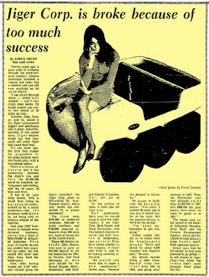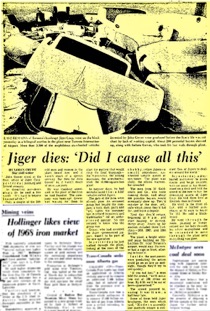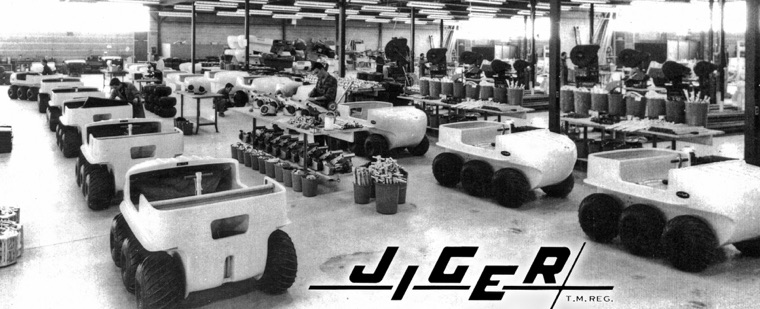
By LOREN CHUDY Toronto Star staff writer
April, 1968
Twenty years ago a man tired of trudging through the snow-covered northern Alberta forestland invented a vehicle that looks like a bathtub and can roll over anything on its slit fat wheels. It can churn through water ― slowly but steadily ― and it can climb steep banks. Its single engine can carry two people at 25 miles an hour. Inventor John Gower, now 44 called it the Jiger (pronounced jigger) and sportsmen tall it great, beautiful, exciting, if you asked them. Jiger dealers would say that they could sell every Jiger that came their way. Yet one week ago, the firm that makes the go-anywhere fibreglass bathtub went into bankruptcy with a resounding splash. There is a reason, of course, and it lies somewhere between the Jiger's rise and fall, the $1,010,000 spent on research, development and tooling, and the 20 years of time and work. It has to do, says John Gower, with a small firm trying to balance its costs―pushed up by a small production―and it’s revenues―held down by not being able to produce enough of the vehicles. Last year 2,627 businesses in Canada were declared insolvent showing a total of $202,479,000 in defaulted liabilities. This year, of course, DO one can predict how many will go under. but the record will show that Jiger Corp. filed for bankruptcy. Nate, after having turned out 3,337 vehicles (Gower gives the figure instantly) the Jiger Corp. plant on McLachlan Dr. near Toronto airport, which only weeks ago employed 75, is almost abandoned. The firm owes $100,000 to preferred creditors. $250,000 to trade creditors, and $740,000 received as deposits from 500 dealers, most of whom are In the United States. Those 500 dealers include John Mason, who says he gave an $13,000 deposit to get the dealership for Metro Toronto. And Paul Morrissey Jr., who gave $10,000 for the Grand Rapids, Mich., dealership, and Howard Taleski of London, Ont., who put up $1500. On the surface at least, it looks like the Jiger is up. But underneath, there may be enough going to save the Jiger vehicle, if not Jiger Corp. Both Gower and Mark Perlmutter, who was named interim receiver and later trustee in  bankruptcy, says several firms have shown interest in the company. A major auto firm is said to be looking carefully at the firm. We would very much like to make a new combination," Gower says. "Because the demand is fantastic." He pauses to think over the developments. "You know, I started 20 years ago in this and it looked easier at the start. But the question always is, when do you go big? "I've done my damnedest to get this going." Gower sounds sadder as he thinks what the bankruptcy means. "We're sold ahead by about 9000 vehicles with deposits paid," he says. His efforts include filling a joint Canadian-U.S. army contract from 1111.1 to 1964, and going commercial in 1964. Trustee Perlmutter says that although sales were $1,300,000 in 1967 and 888,000 the year before, there were no sales to speak of in 1965." The banks said no. He turned to the federal Industrial Development Bank and Ontario Development Agency, which are designed to help industry when banks won't. Both agencies said no Gower says that by December he had even planned to go public to sell shares in Jiger Corp.―but when the loans didn't come through, these plans fell flat.
bankruptcy, says several firms have shown interest in the company. A major auto firm is said to be looking carefully at the firm. We would very much like to make a new combination," Gower says. "Because the demand is fantastic." He pauses to think over the developments. "You know, I started 20 years ago in this and it looked easier at the start. But the question always is, when do you go big? "I've done my damnedest to get this going." Gower sounds sadder as he thinks what the bankruptcy means. "We're sold ahead by about 9000 vehicles with deposits paid," he says. His efforts include filling a joint Canadian-U.S. army contract from 1111.1 to 1964, and going commercial in 1964. Trustee Perlmutter says that although sales were $1,300,000 in 1967 and 888,000 the year before, there were no sales to speak of in 1965." The banks said no. He turned to the federal Industrial Development Bank and Ontario Development Agency, which are designed to help industry when banks won't. Both agencies said no Gower says that by December he had even planned to go public to sell shares in Jiger Corp.―but when the loans didn't come through, these plans fell flat.





